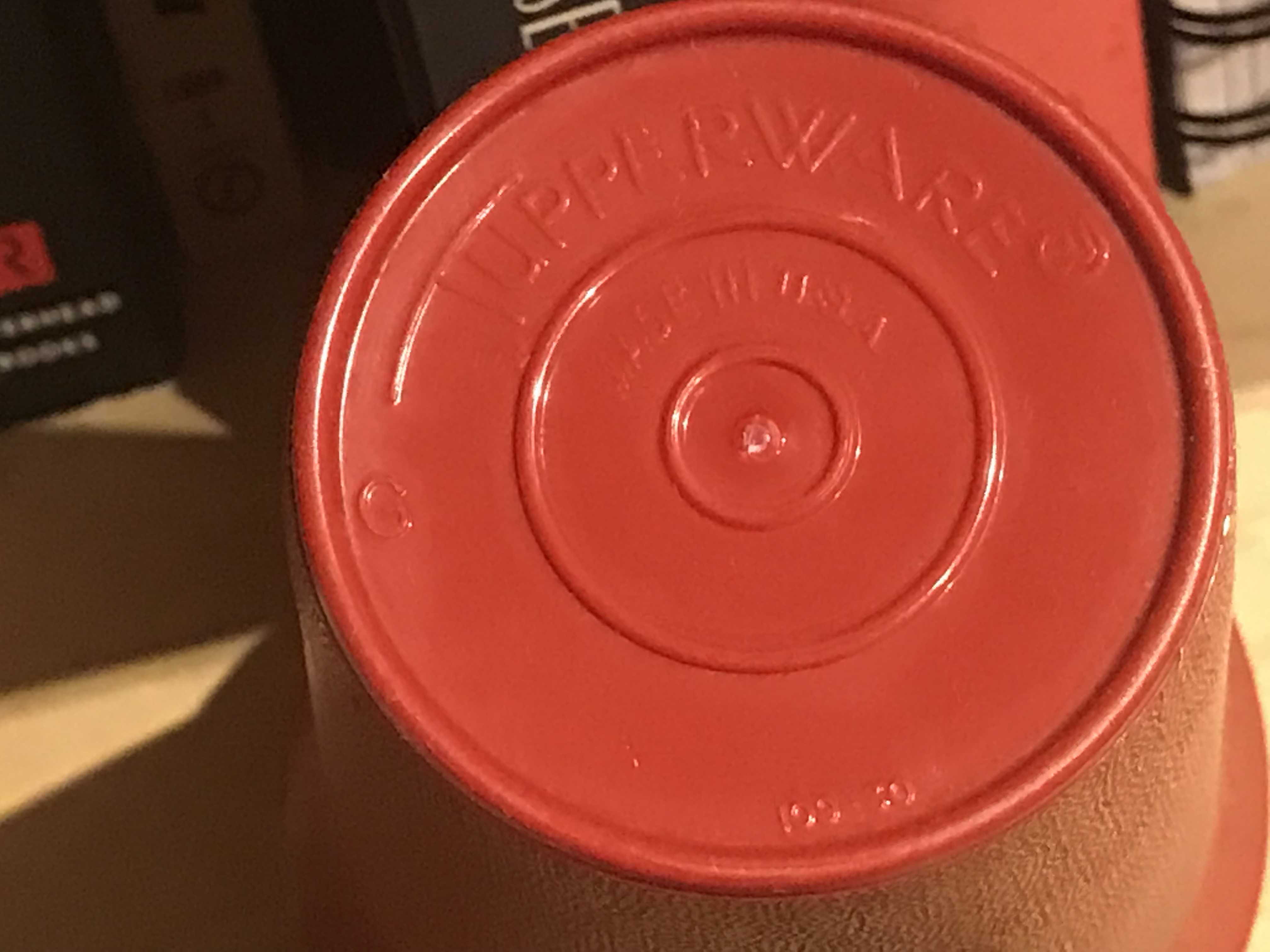Vintage Tupperware Cup. Year Made Unknown. Unlike other colors it is negative for Lead, Mercury, Cadmium & Arsenic.
To see more Tupperware items I have tested, click here.
When using an XRF instrument to test the cup pictured here (which is made of solid red plastic with no painted markings or decorations) it had the following readings:
- Barium (Ba): 162 +/- 90 ppm
- Zinc (Zn): 66 +/- 8 ppm
- Copper (Cu): 23 +/- 13 ppm
- Iron (Fe): 41 +/- 17 ppm
- Titanium (Ti): 835 +/- 229 ppm
All test results reported on this blog are replicable, science-based and accurate. The test result set above was for a test of the item pictured for a full 60 seconds (one minute) in “Consumer Goods” mode. If a metal is not listed above, it was not detected by the XRF instrument in this mode when testing the item pictured here.
A word of caution, given it is nearly impossible to tell the exact year of manufacture of a Tupperware product, the fact that this red cup is negative for Lead, Cadmium, Mercury and Arsenic does not mean that all other red Tupperware items will also be negative. More testing and research is necessary to make that determination. That said, all dark red Tupperware items I have tested to date (about 10 items so far) have been negative for the five primary heavy metals that I look for in my work (Lead, Cadmium, Antimony, Arsenic and Mercury.)
If you have any information that could help date this particular cup that would be very much appreciated. Thank you for supporting this work in this way.
If you appreciate this work and would like to see more test results like this, please consider contributing to the GoFundMe for my advocacy work: http://www.GoFundMe.com/LeadSafeMama. I do “take requests” as I live near quite a few antique stores and could easily go purchase something that you might want tested if the cost of the item were covered and a contribution that also helped with the cost of testing was made. Please e-mail me if you are interested in having me purchase something specific to test (and are in a position to help cover the cost.)
As always, thank you for reading and for sharing my posts.
Please let me know if you have any questions.
Never Miss an Important Article Again!
Join our Email List







Regarding the red Tupperware tumbler. This looks like one of the colors from the early to mid-80s. It was in use when I sold Tupperware around 1982-84. I’m not sure how long before or after it started and ended. It’s difficult to tell for sure which shade of red it is. Many of their various sets of tumblers, mixing bowls, snack cups,sandwich keepers, etc., came in sets of 4 (mixing bowls in 3) that included one of each of 4 colors called cranberry, paprika, butterscotch, and a yellow shade which the name of escapes me. I can’t tell for sure from the photo is this is cranberry or paprika. The cranberry was the darker of the 2. My best guess is that this is paprika, but they are fairly similar so it’s hard to be for certain because of variations of how colors show up in photos and on various computer screens.
Note: the yellow used in these sets was different from the yellow measuring cups you showed in a separate article. Measuring cups during this color era were butterscotch.
I still have and use so much Tupperware. These articles make me cringe because I now want to know the safety on every single color.
I have a red cup like this purchased new in the late 90s. The markings on the bottom are the same but I can’t make out the number on yours, mine is 109 37. The other colours in the set end in 33, 34, and 38 so it’s possible this refers to a colour rather than a batch but that’s just a guess. My red has a slightly pinkish cast depending on the lighting.
Thank you so much for commenting, Dee!
Tamara
I have a cup just like that only it is green. Is it ok?
Hi Sharla,
Thank you for commenting. In green it may have a composition similar to this: https://tamararubin.com/2019/03/vintage-tupperware-green-bowl-2780-ppm-lead-234-ppm-arsenic-both-metals-are-poisonous-to-humans/
Tamara
Are you able to share the studies that replicate your findings? Thanks!
Hi Christine,
To my knowledge no one else has studied this besides me (specifically with regards to Tupperware.) However the vintage plastics studies (for toys) are linked in the main (first) Tupperware post that went viral: https://tamararubin.com/2019/03/stop-using-your-vintage-tupperware-now-these-measuring-cups-are-positive-for-2103-ppm-lead-250-ppm-arsenic/
We are petitioning Tupperware to address the concern and – so far – “crickets”. Here’s the petition link: https://www.change.org/p/tupperware-corporate-tupperware-respond-re-leadsafemama-s-findings-of-lead-arsenic-in-your-vintage-products?recruiter=7021750&utm_source=share_petition&utm_medium=copylink&utm_campaign=share_petition&utm_term=share_petition
Thank you for commenting.
Tamara
My family has varying colors (mainly deep blue in color) along with the yellow and white sippy lids that are interchangeable with the different kids cups. To my knowledge they had to have been purchased either late 80’s early 90s (more than likely early 90’s as my sister was born in 88). I am sad to see vintage Tupperware is not good as it’s been something we’ve been passed down (including way older pieces such as a mute pink tea pitcher) and have been using! Definitely going to share this with family as I can’t even count the items my mom has in her home! Thanks for doing what you do’